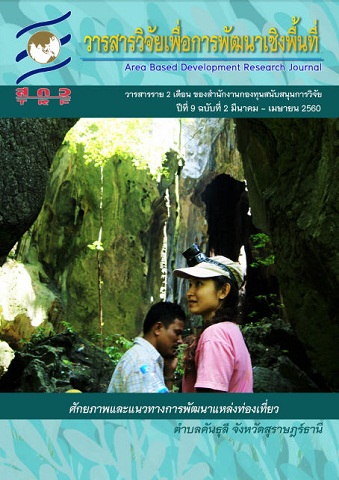รูปแบบการเสริมสร้างสุขภาพของผู้ป่วยเบาหวานด้วยสมุนไพรพื้นบ้าน โดยกระบวนการสิ่งแวดล้อมศึกษา
Main Article Content
Abstract
งานวิจัยนี้มีวัตถุประสงค์เพื่อสร้างและพัฒนารูปแบบการเสริมสร้างสุขภาพของผู้ป่วยเบาหวานด้วยสมุนไพรพื้นบ้านโดยกระบวนการสิ่งแวดล้อมศึกษา ประเมินความพึงพอใจต่อการใช้รูปแบบ เปรียบเทียบความรู้ ความตระหนักและพฤติกรรมก่อนกับหลังการใช้รูปแบบและผลการเปลี่ยนแปลงระดับน้ำตาลในเลือดของผู้ป่วย พื้นที่วิจัยคือ โรงพยาบาลกบินทร์บุรี จังหวัดปราจีนบุรี กลุ่มเป้าหมายในการวิจัย มี 4 กลุ่ม ได้แก่ 1) กลุ่มแพทย์ เภสัชกร พยาบาลวิชาชีพในคลินิกเบาหวานจำนวน 10 คน โดยการจัดสนทนากลุ่ม 2) กลุ่มผู้ทรงคุณวุฒิ 5 คน 3) กลุ่มผู้ป่วยโรคเบาหวานที่ไม่สามารถควบคุมระดับน้ำตาลในเลือดได้ จำนวน 60 คน และ 4) กลุ่มญาติผู้ดูแลผู้ป่วยในครอบครัว จำนวน 60 คน เครื่องมือที่ใช้ในการวิจัย มีจำนวน 5 ชุด ดังนี้ 1) ประเด็นคำถามในการสนทนากลุ่มเพื่อสร้างและพัฒนารูปแบบ 2) แบบประเมินคุณภาพของรูปแบบ 3) ชุดการเรียนรู้การเสริมสร้างสุขภาพด้วยสมุนไพรพื้นบ้าน 4) แบบประเมินความพึงพอใจต่อรูปแบบ5) แบบบันทึกผลการเปลี่ยนแปลงน้ำตาลในเลือดด้วยเครื่อง ACCU-Check ผลการศึกษา พบว่า รูปแบบการเสริมสร้างสุขภาพของผู้ป่วยเบาหวานด้วยสมุนไพรพื้นบ้านที่ได้จากการจัดสนทนากลุ่ม มี 3 องค์ประกอบ ดังนี้ องค์ประกอบแรก คือ หลักการใช้การเรียนรู้โดยเน้นการปฏิบัติการ องค์ประกอบที่สอง คือ กระบวนการและวิธีการเสริมสร้างสุขภาพ ที่ผ่านการประเมินและปรับปรุงตามข้อเสนอแนะโดยผู้ทรงคุณวุฒิ มี 5 ขั้นตอน ได้แก่ 1) รับรู้ปัญหาโดยใช้กระบวนการกลุ่มและการสร้างสัมพันธภาพ 2) จัดการเรียนรู้ โดยการบรรยาย 3) สร้างความตระหนัก โดยการสาธิต 4) สร้างทักษะ โดยให้ผู้ป่วยทำอาหารสมุนไพรบริโภคตามสูตรในคู่มือสมุนไพรพื้นบ้านที่ผู้วิจัยสร้างขึ้น 5) ให้ผู้ป่วยมีส่วนร่วมดูแลสุขภาพตนเอง โดยการสนับสนุนของสมาชิกในครอบครัวและการแลกเปลี่ยนเรียนรู้ระหว่างผู้ป่วย องค์ประกอบสุดท้าย ได้แก่ ปัจจัยสนับสนุนการดำเนินตามรูปแบบต้องมีผู้เชี่ยวชาญให้คำแนะนำใกล้ชิด มีญาติและครอบครัวผู้ป่วยดูแลสนับสนุน มีสื่ออุปกรณ์ สื่อการเรียนรู้สมุนไพรพื้นบ้าน ความพึงพอใจของผู้ป่วยต่อรูปแบบการเสริมสร้างสุขภาพของผู้ป่วยเบาหวานด้วยสมุนไพรพื้นบ้าน โดยรวมอยู่ในระดับมาก (x= 4.16, SD = 0.95) ด้านที่มีความพึงพอใจมาก คือ การสร้างทักษะโดยฝึกปฏิบัติการใช้สมุนไพรและอาหาร (x= 4.12, SD = 0.98) และการจัดกิจกรรมเรียนรู้การใช้สมุนไพรที่เหมาะสมโดยการบรรยาย (x= 4.08, SD = 0.88) สมาชิกในครอบครัวของผู้ป่วยมีความพึงพอใจต่อรูปแบบโดยรวมอยู่ในระดับมาก (x= 4.21, SD = 0.88) ด้านที่มีความพึงพอใจมาก คือ การจัดกิจกรรมเรียนรู้โดยการบรรยาย (x= 4.32, SD = 0.88 ) และ การสร้างทักษะโดยการฝึกปฏิบัติการใช้สมุนไพรและอาหาร (x= 4.24, SD = 0.85) ผลการเปรียบเทียบระดับน้ำตาลในเลือดพบว่า 6 เดือนหลังเข้าร่วมกิจกรรมมีระดับน้ำตาลในเลือดลดลงกว่ากลุ่มควบคุม
Model of Health Promotion of Diabetes Mellitus Patients with Traditional Herbs by Using Environment Education Process
The objectives of this research were to 1) construct and develop the model for potential increase in using traditional herbs to enhance the health of Diabetes Mellitus Type 2 patients by environmental education, and 2) evaluate the satisfaction of the Diabetes Melitus Type 2 patients and their family members towards the proposed model. The focus research site was Kabinburi Hospital, Prachinburi Province. The research focus groups included: 1) ten persons from the group of medical physicians, pharmacists, and registered nurses at the Diabetes Clinic, Kabinburi Hospital; 2) five expert persons; 3) sixty patients of Diabetes Mellitus Type 2 who were poor glycemic control, and 4) sixty family members of those sixty patients. The six research instruments were used for this research included 1) question points for group discussion; 2) an evaluation form for the model congruity; 3) the criteria for participatory action research using group dynamics technique; 4) handbook for potential increase in using traditional herbs to enhance the health of Diabetes Mellitus Type 2 patients by environmental education; 5) a form of record of using traditional herbs to enhance the health of Diabetes Mellitus Type 2 patients; and 6) a satisfaction evaluation form. The results were that:
The construction of the model for potential increase in using traditional herbs to enhance the health of Diabetes Mellitus Type 2 patients by environmental education consists of 3 components. The first component is Principle of learning by doing. In the second component, five steps of process management are as follows; 1) Relationship building using group dynamic activities and problem recognition by way of group analysis method, 2) Knowledge management by lecturing, 3) Awareness building through demonstration method, 4) Skill building by encouraging the patients to cook herbal food according the recipes in the handbook of herbs composed by the researcher and 5) Participating for mutual recognition of the patients’ problems, by allowing the patients to do self-healthcare with the supports from their family members and learning exchange among the patients. The third component is Supporting factors. The researcher had to have the expert available to give suggestions and monitor. In addition, the researcher had to arrange for the patients’ family members to provide support and take care of’ the patients, including information about traditional herbs from media, and equipment. In terms of the patient satisfaction towards the development model, the overall satisfaction was at good level ( = 4.16; SD = 0.95). When considered at each factor, the factor of participation, and skill building by demonstration received the highest level of satisfaction (
= 4.12; SD = 0.98) followed by the learning activity by lecturing about using appropriate herbs (
= 4.08; SD = 0.88). Besides, the results revealed that the family members had overall satisfaction towards the development model at good level (
= 4.21; SD = 0.88). When considering at each factor, the factor that received the highest satisfaction was the learning activity of using the appropriate herbs by lecturing (
= 4.32; SD = 0.88) followed by the skill building by demonstrating the use of traditional herbs for consumption (
= 4.24; SD = 0.85).
Article Details
Area Based Development Research Journal values copyright protection and licensing to safeguard author rights and facilitate the appropriate dissemination of research. Our policies ensure openness, accessibility, and attribution. Authors retain copyright ownership, and articles are published under a Creative Commons Attribution License (CC BY), allowing sharing, adaptation, and proper attribution. Authors have the freedom to publish under the CC BY license, granting broad reuse and distribution permissions. The journal supports posting articles on third-party repositories, adhering to institutional and funding restrictions. Author guidelines detail copyright and licensing requirements, empowering authors with knowledge about their rights and responsibilities. These policies cultivate an environment of collaboration, openness, and responsible sharing, benefiting authors and the research community while honoring intellectual property rights.


